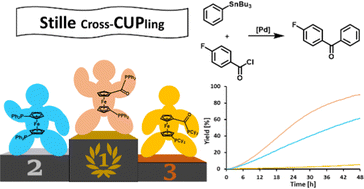Synthesis, coordination behavior, and catalytic properties of dppf congeners with an inserted carbonyl moiety†‡
Abstract
Ferrocene phosphines have been extensively studied as ligands for coordination chemistry and catalysis. Among the vast number of compounds reported to date, 1,1′-bis(diphenylphosphino)ferrocene (dppf) still holds a prominent place due to its versatile coordination behavior and wide catalytic applications. This paper describes the synthesis of four semihomologous dppf congeners with a carbonyl spacer inserted between the ferrocene unit and one of the phosphine moieties, R2PfcC(O)PR′2 (R/R′ = Ph/Ph, Ph/Cy, Cy/Ph and Cy/Cy; Cy = cyclohexyl and fc = ferrocene-1,1′-diyl). These compounds were prepared from the respective borane-protected phosphinocarboxylic acids R2PfcCO2H·BH3 by chlorination with oxalyl chloride, reaction with HPR′2/NEt3 and subsequent removal of the protecting group. The compounds were further converted to selenides R2P(Se)fcC(O)P(Se)R′2 to evaluate their electronic properties through the 1JPSe coupling constants. In addition, two series of palladium complexes were prepared, viz. the Pd(II) chelate complexes cis-[PdCl2(R2PfcC(O)PR′2-κ2P,P′)] and the Pd(0) complexes [Pd(η2-mi)(R2PfcC(O)PR′2-κ2P,P′)] (mi = N-methylmaleimide). The latter compounds were applied as catalysts for the Stille cross-coupling reaction of 4-fluorobenzoyl chloride with phenyl-tributylstannane to produce 4-fluorobiphenyl. The best catalytic results were obtained with the [Pd(η2-mi)(Ph2PfcC(O)PPh2-κ2P,P′)] complex that contained the least electron-rich ligand.



 Please wait while we load your content...
Please wait while we load your content...